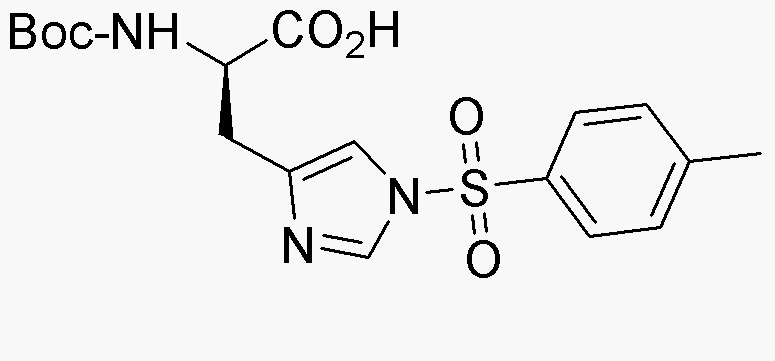Na-Boc-Nim-4-toluenesylfonyl-D-histidine is widely utilized in research focused on:
- Peptide Synthesis: This compound serves as a key building block in the synthesis of peptides, particularly in creating modified peptides with enhanced stability and bioactivity, which are essential in drug development.
- Drug Design: It plays a critical role in the design of pharmaceutical agents, especially in targeting specific biological pathways, making it valuable in the pharmaceutical industry for developing new therapies.
- Bioconjugation: The compound is used in bioconjugation techniques, allowing researchers to attach biomolecules to drugs or imaging agents, improving their efficacy and targeting capabilities in therapeutic applications.
- Research in Cancer Therapy: Its unique properties make it suitable for developing targeted cancer therapies, where precision in drug delivery is crucial for minimizing side effects and maximizing treatment efficacy.
- Protein Engineering: This chemical is utilized in protein engineering to modify amino acid sequences, enhancing the functionality and stability of proteins for various applications in biotechnology and medicine.
General Information
Properties
Safety and Regulations
Applications
Na-Boc-Nim-4-toluenesylfonyl-D-histidine is widely utilized in research focused on:
- Peptide Synthesis: This compound serves as a key building block in the synthesis of peptides, particularly in creating modified peptides with enhanced stability and bioactivity, which are essential in drug development.
- Drug Design: It plays a critical role in the design of pharmaceutical agents, especially in targeting specific biological pathways, making it valuable in the pharmaceutical industry for developing new therapies.
- Bioconjugation: The compound is used in bioconjugation techniques, allowing researchers to attach biomolecules to drugs or imaging agents, improving their efficacy and targeting capabilities in therapeutic applications.
- Research in Cancer Therapy: Its unique properties make it suitable for developing targeted cancer therapies, where precision in drug delivery is crucial for minimizing side effects and maximizing treatment efficacy.
- Protein Engineering: This chemical is utilized in protein engineering to modify amino acid sequences, enhancing the functionality and stability of proteins for various applications in biotechnology and medicine.
Documents
Safety Data Sheets (SDS)
The SDS provides comprehensive safety information on handling, storage, and disposal of the product.
Product Specification (PS)
The PS provides a comprehensive breakdown of the product’s properties, including chemical composition, physical state, purity, and storage requirements. It also details acceptable quality ranges and the product's intended applications.
Certificates of Analysis (COA)
Search for Certificates of Analysis (COA) by entering the products Lot Number. Lot and Batch Numbers can be found on a product’s label following the words ‘Lot’ or ‘Batch’.
*Catalog Number
*Lot Number
Certificates Of Origin (COO)
This COO confirms the country where the product was manufactured, and also details the materials and components used in it and whether it is derived from natural, synthetic, or other specific sources. This certificate may be required for customs, trade, and regulatory compliance.
*Catalog Number
*Lot Number
Safety Data Sheets (SDS)
The SDS provides comprehensive safety information on handling, storage, and disposal of the product.
DownloadProduct Specification (PS)
The PS provides a comprehensive breakdown of the product’s properties, including chemical composition, physical state, purity, and storage requirements. It also details acceptable quality ranges and the product's intended applications.
DownloadCertificates of Analysis (COA)
Search for Certificates of Analysis (COA) by entering the products Lot Number. Lot and Batch Numbers can be found on a product’s label following the words ‘Lot’ or ‘Batch’.
*Catalog Number
*Lot Number
Certificates Of Origin (COO)
This COO confirms the country where the product was manufactured, and also details the materials and components used in it and whether it is derived from natural, synthetic, or other specific sources. This certificate may be required for customs, trade, and regulatory compliance.


